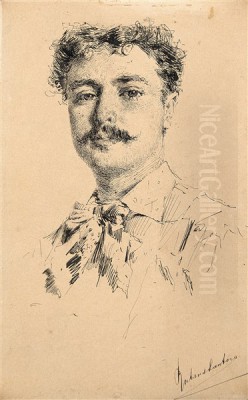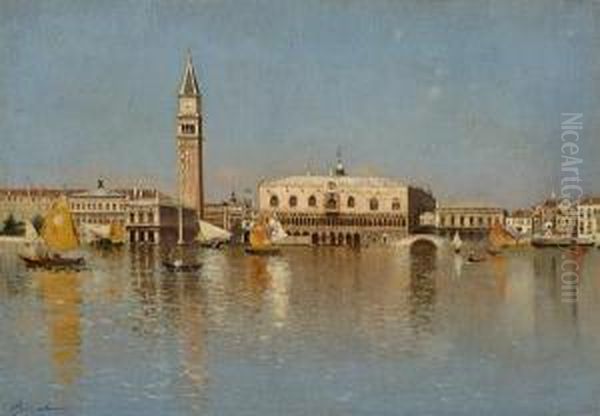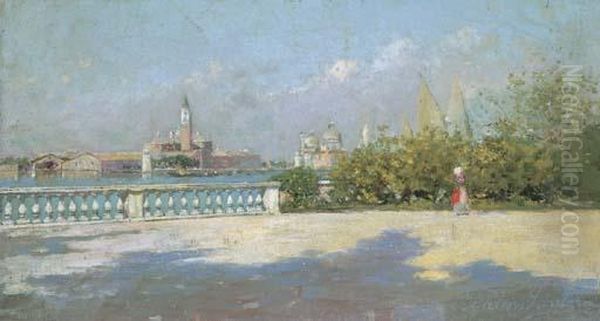
Rubens Santoro stands as a significant figure in late 19th and early 20th-century Italian art, celebrated primarily for his luminous and meticulously detailed paintings of Venice. Born in 1859 and active until his death in 1942, Santoro dedicated much of his prolific career to capturing the unique atmosphere, architectural splendor, and everyday life of the lagoon city. His work, while rooted in the Italian Realist tradition, developed a distinctive character marked by brilliant light, clear colors, and an almost photographic attention to detail, securing him lasting international appeal.
Early Life and Artistic Awakening in Naples
Rubens Santoro was born in Mongrassano, a mountain village in Calabria, Southern Italy, in 1859. His artistic inclinations were perhaps preordained; his father, Giovanni Battista Santoro, was a sculptor and painter of some note. Seeking a future in the arts for his son, Giovanni Battista named him after the great Flemish Baroque master, Peter Paul Rubens, a testament to the high artistic aspirations held for the young boy. This connection, though nominal, placed Santoro from birth within a lineage of artistic ambition.
At the age of ten, the Santoro family relocated to Naples, a vibrant cultural and artistic hub. This move proved pivotal for the young Rubens. He soon enrolled at the prestigious Naples Academy of Fine Arts (Accademia di Belle Arti di Napoli). There, he came under the influence of Domenico Morelli, a leading figure of the Neapolitan School and a major force in 19th-century Italian painting. Morelli was known for his historical and religious subjects, rendered with dramatic flair and a focus on realism and emotional intensity.
However, Santoro reportedly found the formal academic training restrictive. Like many artists of his generation seeking a more direct engagement with the world, he felt drawn away from the studio and towards the direct observation of nature and life. He left the Academy prematurely, choosing instead to pursue his artistic education independently, focusing particularly on landscape painting and working en plein air (outdoors). This decision set the stage for his later specialization in cityscapes and landscapes, where direct observation was paramount.
The Neapolitan Milieu and Formative Influences

Naples in the latter half of the 19th century was a crucible of artistic innovation, particularly in the realm of Realism. The Neapolitan School, with figures like Morelli, Filippo Palizzi, and later Antonio Mancini and Francesco Paolo Michetti, emphasized truthfulness to nature, often depicting scenes of local life, landscapes, and the effects of southern Italian light. Santoro absorbed this atmosphere, honing his skills in capturing the tangible world around him.
A crucial encounter occurred in 1874 when Santoro met the internationally renowned Spanish painter Mariano Fortuny y Madrazo, who was visiting Naples. Fortuny, known for his dazzling technique, brilliant color, and often historical or Orientalist genre scenes, had a profound impact on many artists of the period. For Santoro, Fortuny's influence seems to have encouraged a brighter palette and perhaps a more virtuosic handling of paint, complementing the Neapolitan emphasis on realism. Some accounts suggest Santoro began blending Fortuny's brilliance with the styles of Neapolitan contemporaries like Vincenzo Migliaro, Giuseppe Casciaro, and Pietro Scoppetta, further refining his approach.
During these formative years, Santoro began exhibiting his work. In 1874, he participated in the Naples "Promotrice" exhibition, showing works like Una fanciulla che fa la calza (A Girl Knitting), demonstrating his early commitment to realistic genre subjects. His participation in the Naples National Exhibition in 1877 with works such as Marina di Maiori and Grotta degli Zingari brought him further attention. These paintings were reportedly acquired by the prominent Parisian art dealers Goupil & Cie, indicating early international interest in his work.
The Enduring Fascination with Venice
While Naples provided his artistic grounding, it was Venice that would capture Santoro's imagination and become the central motif of his long career. He began visiting the city frequently around 1874 or 1875, and its unique combination of water, light, and architecture proved an inexhaustible source of inspiration. He joined a long line of artists captivated by Venice, stretching back to the 18th-century masters of the veduta (view painting), such as Canaletto, Bernardo Bellotto, and Francesco Guardi, and continuing with international visitors like J.M.W. Turner and later Claude Monet.
Santoro, however, developed his own distinct vision of Venice. While acknowledging the veduta tradition's emphasis on topographical accuracy, his work often focused on the more intimate and picturesque aspects of the city. He painted the grand vistas of the Grand Canal and St. Mark's Square, but he seemed equally drawn to the quiet side canals, the crumbling plaster of ancient palazzi, the play of sunlight on water, and the small details of daily life – gondoliers resting, figures crossing bridges, laundry hanging between buildings.

His approach was characterized by a remarkable clarity and luminosity. He excelled at capturing the distinctive Venetian light – sometimes bright and sharp, reflecting off the water and buildings, other times soft and hazy, suffusing the scene with atmosphere. His palette was typically bright and clean, employing blues, whites, reds, and ochres to render the architecture, water, and sky with vibrancy.
Mastering the Venetian Veduta
Santoro's Venetian paintings became his trademark and were highly sought after by collectors, particularly in Italy, Britain, and the Americas. His technique was meticulous. He paid close attention to architectural detail, rendering the intricate facades of palaces, churches, and bridges with precision. The textures of stone, brick, water, and fabric were carefully observed and translated onto canvas.
Water, the defining element of Venice, was a particular focus. Santoro masterfully depicted its reflective qualities, capturing the shimmering images of buildings and boats on the canal surfaces. He conveyed the transparency of the water in shallower areas and the deeper, richer tones of the main canals. Gondolas, ubiquitous in Venice, feature prominently in his work, often rendered with loving detail, serving both as compositional elements and symbols of Venetian life.
Representative works showcase his skill and typical subjects. Titles like Grand Canal, Venice, Rio dei Mendicanti, Venice, A Back Canal, Venice, Ponte della Paglia, and Venice, Gondola Approaching the Piombi evoke the scenes he favored. While often depicting well-known landmarks like St. Mark's Basilica or the Doge's Palace, they frequently appear as part of a broader, lived-in cityscape rather than isolated monuments. His paintings often possess a serene, almost timeless quality, capturing moments of quiet beauty amidst the city's bustle.
Exhibitions, Recognition, and International Career
Santoro actively participated in the major art exhibitions of his time, both in Italy and abroad, building a solid reputation. He exhibited regularly in Naples, Rome, Turin (including the Esposizione Generale Italiana of 1880), and Milan. His Venetian scenes proved particularly popular and were frequently featured at the Venice Biennale exhibitions, a major international showcase for contemporary art established in 1895.
His work gained significant international exposure. He exhibited at the prestigious Paris Salon and sent paintings to London. His participation in major world's fairs, such as the World's Columbian Exposition in Chicago (1893) and the International Exhibition in Buenos Aires (1910), brought his art to a global audience. This international success was reflected in awards, such as the silver medal he received at the Exposició Internacional d'Art in Barcelona in 1911.

The demand for his work, particularly his Venetian views, was strong throughout his career. Dealers like Goupil & Cie played a role in promoting his art internationally. His paintings entered numerous private collections across Europe and America. His success allowed him to dedicate himself almost entirely to his art, maintaining studios in Naples and Venice, and traveling as needed. In recognition of his standing, he was appointed an honorary professor at the Naples Academy of Fine Arts, the institution he had once left prematurely.
Artistic Style: Realism, Light, and Detail
Santoro's style is best categorized within the broader movement of late 19th-century European Realism and Naturalism, but with a specific focus inherited from the Italian veduta tradition. Unlike the French Impressionists, who sought to capture fleeting moments and the subjective experience of light and color with broken brushwork, Santoro maintained a high degree of finish and detail. His realism was descriptive and objective, aiming for a faithful representation of the scene before him, albeit often idealized for picturesque effect.
His mastery of light was central to his art. He understood how light interacted with Venice's unique environment – reflecting off water, illuminating facades, casting deep shadows in narrow alleyways. This sensitivity to light gives his paintings their characteristic luminosity and atmospheric depth. While working outdoors (en plein air) undoubtedly informed his understanding of light and color, his finished paintings often display a meticulousness that suggests careful studio work refining outdoor sketches.
His color palette, while based on observation, was often heightened for clarity and vibrancy. The blues of the sky and water, the warm tones of brick and stone, and the occasional bright accents of figures' clothing or boat decorations contribute to the cheerful and appealing quality of many of his works. His draftsmanship was strong, underpinning the detailed rendering of architecture and figures.
While influenced by older masters indirectly through the veduta tradition (Canaletto, Guardi) and perhaps absorbing lessons in light and drama from Baroque painters like Caravaggio or even his namesake Rubens via his general art education, Santoro's primary artistic dialogue was with the Realism of his own time, particularly the Neapolitan variant shaped by Morelli and the dazzling technique exemplified by Fortuny. He carved out a niche by applying these principles with exceptional skill to the perennially popular subject of Venice.
Later Years and Enduring Legacy

Rubens Santoro remained active as a painter for decades, continuing to produce his sought-after Venetian scenes well into the 20th century. He reportedly stayed in Venice and continued to paint even during the difficult years of World War I and leading up to World War II. His dedication to his chosen subject matter remained unwavering. He passed away in 1942 at the age of 83.
His legacy rests firmly on his Venetian paintings. While perhaps not a radical innovator in the mold of the Impressionists or later modernists, Santoro achieved a mastery within his chosen genre that few contemporaries could match. His works offered, and continue to offer, an idealized yet believable vision of Venice – a city of beauty, light, and picturesque charm. His paintings captured a Venice that appealed to the romantic sensibilities of late 19th and early 20th-century audiences, and their popularity endures today.
Art historically, Santoro is recognized as one of the last great exponents of the traditional Venetian veduta. He successfully adapted the genre to the tastes and techniques of his time, blending topographical accuracy with atmospheric realism and a pleasing aesthetic. His contemporaries in Venetian painting included artists like Giacomo Favretto, known for his lively genre scenes, and Guglielmo Ciardi, another skilled landscape and marine painter. Santoro's specific focus on detailed cityscapes set him somewhat apart.
Collections and Critical Standing
Today, Rubens Santoro's paintings are held in numerous public and private collections around the world. While major encyclopedic museums like the British Museum or the Musée d'Orsay might hold examples, his works are perhaps more frequently found in institutions with strong collections of 19th-century European art, such as the Baltimore Museum of Art, the Cincinnati Art Museum, and the Manchester Art Gallery in the UK. Italian museums, particularly in Naples (like the Museo di Capodimonte or Museo di San Martino) and Turin (Galleria Civica d'Arte Moderna e Contemporanea - GAM), also hold examples of his work.
Critical reception during his lifetime was generally positive, particularly regarding his technical skill and the appeal of his subjects. He achieved considerable commercial success. Later art historical assessments acknowledge his skill and his significant contribution to the veduta tradition, placing him as a key figure in Italian painting of his era, particularly in the depiction of Venice. While sometimes seen as conservative compared to the avant-garde movements developing concurrently, the enduring appeal and technical brilliance of his work are undeniable.
Conclusion: A Luminous Vision of Venice
Rubens Santoro dedicated his life to capturing the unique beauty of Venice. Through meticulous detail, a masterful handling of light and color, and a deep affection for his subject, he created a body of work that continues to enchant viewers. Emerging from the Neapolitan Realist tradition and inspired by figures like Domenico Morelli and Mariano Fortuny, he forged a distinctive style perfectly suited to the Venetian cityscape. As one of the last great view painters in the tradition of Canaletto and Guardi, Santoro secured his place in art history, leaving behind a luminous and enduring vision of the Serenissima. His paintings remain a testament to his skill and a beloved window onto the timeless allure of Venice.